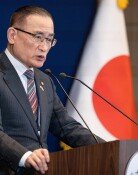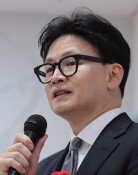Preserving Cultural Treasures
Mr. Kim will retire on June 30 after completing a 32-year career at museums, and he is on vacation at this time. However, he was still wrapping and preserving cultural artifacts on June 26, when we met him at Deoksu Palace. He was transferred to Gyeongbok Palace on August 15, and was helping to wrap cultural properties of the Deoksu Royal Museum, which will reopen as the National Palace Museum of Korea. Earlier this month, he went to Jeonju, Jeonbuk Province to wrap the portrait of Lee Sung-gye, founder of the Joseon Dynasty, which will be displayed at a special exhibition held at the Jeonju National Museum.
One of the works he recently put much energy into was the wrapping of cultural properties which will move to the brand new National Museum of Korea (which will open on October 28) in Yong-san, Seoul. He said that a reliquary (aging back to the mid-eighth century) excavated from Seokga Tower, designated as national treasure 126, was the most difficult artifact he has ever had to treat (among many others, he reports), due to a small decoration hanging on the corner of the reliquary. He said, The decoration was so old that it fell off with a breeze, which made the work very difficult. I had wrapped many cultural properties, but I felt very nervous. I went to work at 7:00 a.m. every day for a whole week, and examined it over for two hours to find a good solution. After long consideration, I rolled a piece of thin acid-free paper to make a pillar beside the decoration, and fixed the decoration and pillar with another piece of paper, which took me two whole days.
It was in 1973 when Mr. Kim went to a museum. He was employed as a temporary worker in the cultural property department of the National Museum of Korea, after quitting university and failing in his business. The first thing he did was to clean the museum. He was criticized for his ignorance of cultural properties. But he studied them very hard, and after three years he was allowed to treat cultural properties at last, which is how he began his career at museums. He became a curator upon passing an exam in 1978. He has actively participated in wrapping cultural properties, as he treated cultural properties to be displayed in the 5,000 Years of Korean Art exhibit displayed in Washington, D.C. and New York. He said, At that time, I knew that there were experts in wrapping cultural properties in the U.S. I was intrigued, and I decided to challenge myself to be such an expert.
It took him a week to wrap a gold crown in 1979, but he has become an expert to the extent that he now needs only 30 minutes for the same work. He said, I wrapped the crown by unfolding the linked parts at the rear of the crown first, but now I make use of a well-fitted frame to wrap the crown more efficiently. When ordinary people lift a crown, its decorations and golden plate will dangle heavily, but I can lift the crown with one hand without shaking even a single decoration. I have learned such know-how after much experience.
His ability to wrap cultural properties is known around the world. He wrapped more than 300 Korean national treasures that were displayed for a special Korean exhibition at the Metropolitan Museum in the U.S. in 1998. When a person from the Metropolitan Museum looked at Mr. Kims work, he offered Mr. Kim a job at that museum. When Jung Yang-mo, chief of the National Museum of Korea at that time, was told the offer, he said a decisive no. He could not let go of a world-renowned expert. The museum extended its retirement age by three years in 2002 when Mr. Kim would have had to retire, and he was promoted to a curator researcher.
Kim states that the attractiveness of wrapping cultural properties is very simple: It is to allow cultural properties that left to come back safely. What has made him feel badly has been the social ignorance regarding the importance of wrapping cultural properties. He lamented, Koreas ability to wrap cultural properties is very high by world standards, but experts in this area are not treated fairly. Thats why he wants to educate more juniors. Currently, many young people are learning from him how to wrap cultural properties.
He will transfer himself to the Jogyejong Museum of Korean Buddhist Art at Gyeonji-dong, Jongno-gu, Seoul in July, and he will wrap cultural properties there as he has done all along.
Kwawg-Pyo Lee kplee@donga.com






![[단독]김경 “1억원 줄때, 강선우도 함께 있었다” 자수서](https://dimg.donga.com/c/138/175/90/1/wps/NEWS/IMAGE/2026/01/14/133148772.5.jpg)
